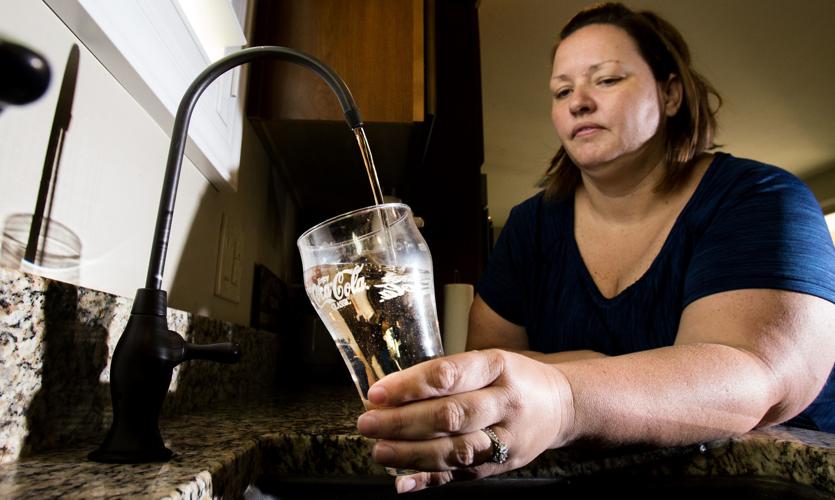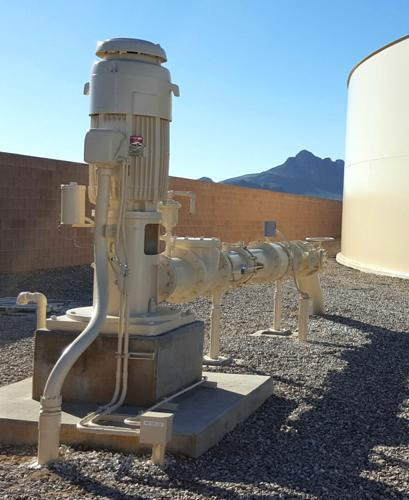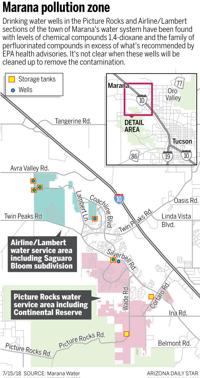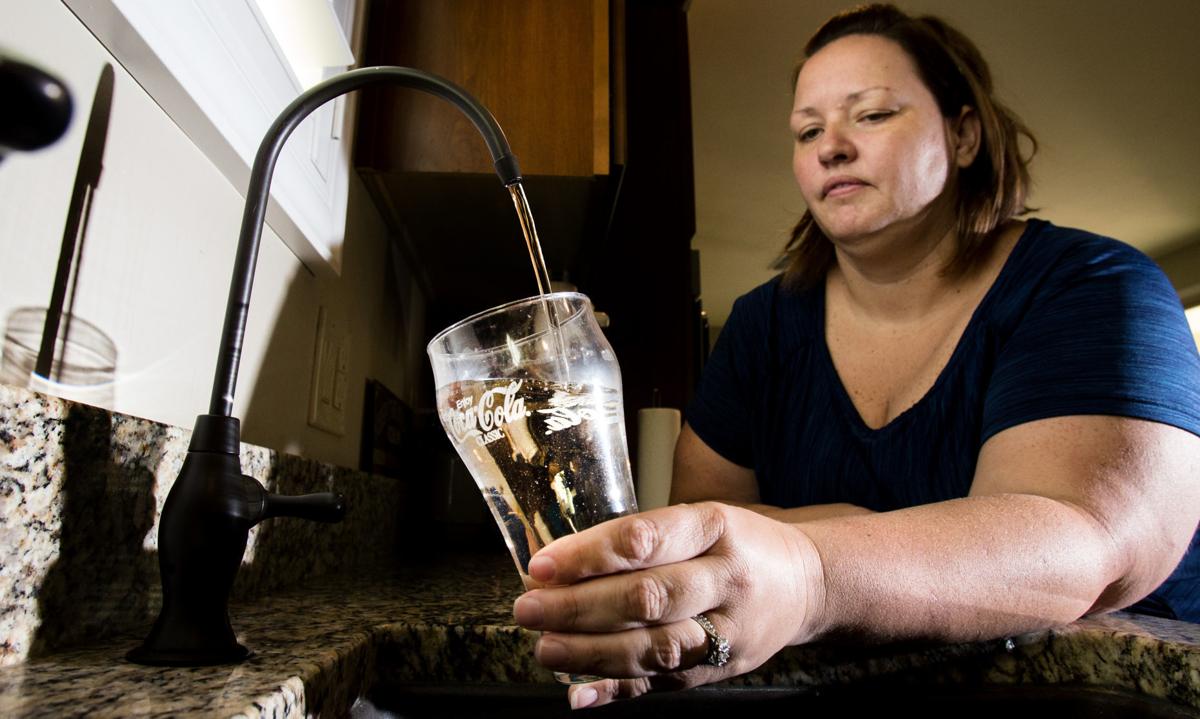It’s not clear when a half-dozen polluted wells serving more than one-third of the Marana water utility’s households will be cleaned up, town officials say.
Since late 2016, Marana Water Department officials have known that these wells contained levels of two kinds of chemical pollutants that are higher than those recommended by the Environmental Protection Agency.
The water utility now has a detailed plan for cleaning up the water. But it’s waiting for federal direction as to how thoroughly the water needs to be cleaned because of changing environmental standards.
In the meantime, residents in affected areas are installing water-treatment systems and buying bottled water as alternatives to drinking polluted tap water.
One of the pollutants is 1,4-dioxane, a synthetic industrial chemical that is used to stabilize common industrial solvents. It’s now being cleaned up from long-contaminated groundwater on Tucson’s south side.
The other consists of two man-made industrial compounds belonging to a suite of compounds known as per- and polyfluoroalkyl substances, or PFAS for short. Those also are known to have polluted two drinking wells on Tucson’s southeast side, just north of Davis-Monthan Air Force Base.
Both dioxane and PFAS are known to cause a wide range of health effects. Dioxane is considered a likely human carcinogen by the EPA for those who ingest it over a lifetime. The EPA considers some forms of PFAS, including those found in the Marana wells, as possible human carcinogens for lifetime exposure. Neither one breaks down easily, and neither is regulated by the federal government, meaning there’s no formal limits for how much can be in drinking water.
The polluted wells are centered in two areas of Marana and serve nearly 2,800 customers, mostly homes, out of the town water utility’s 7,715 customers. Those customers don’t include residents of Marana’s huge Continental Ranch development, which Tucson Water serves and is unaffected by this pollution.
One affected well system serves Saguaro Bloom, a burgeoning subdivision lying in the Twin Peaks area near Interstate 10, and also the Happy Acres, Milligan’s Acres and La Puerta subdivisions.
The other serves the major Continental Reserve subdivision lying west of Silverbell Road stretching from the Twin Peaks area south to south of Ina Road, and also serves the Ironwood Reserve and Sunset Ranch projects.
The same Continental Reserve-area groundwater will also serve the future Lazy K Bar Ranch development, an upscale project of 178 homes near the boundary of Saguaro National Park West, whose rezoning was approved by the Marana Town Council last year.

The polluted wells serve more than one-third of the Marana water utility’s customers.
Cleanup plan on hold
As for cleanup, Marana Water released a detailed study last December recommending the use of several treatment methods for the Continental Reserve and Saguaro Bloom wells. The estimated tab: about $15 million to build and operate the treatment plants over 20 years.
But before moving to get the money, which the town doesn’t have, officials want more direction from the EPA as to how thoroughly to treat the water, said John Kmiec, the water utility’s director.
The EPA plans to release criteria for cleaning PFAS compounds from groundwater and soil this fall. It’s also going through a lengthy, detailed analysis to determine whether it should set formal drinking water limits for the two PFAS compounds that have been found in Marana’s drinking water. It faces a legal deadline of 2021 to make a decision on that.
Also, a second federal agency, the Agency for Toxic Substances and Disease Registry, last month released a report that strongly suggested PFAS exposure to humans be dramatically reduced. For drinking water, that would amount to lowering the recommended level from 70 parts per trillion to 7 parts per trillion of one PFAS compound and 11 ppt for another one.
If the EPA lowers or raises its PFAS recommendations for drinking water, that will dictate a possible change in Marana water-treatment goals, possibly changing the cost significantly, Kmiec said.
“As a drinking water provider, our guidance comes from EPA,” Kmiec said.
While no changes are planned for recommended dioxane levels in drinking water, the town wants to build the treatment projects for both sets of chemicals at once. There are cost benefits to that strategy, said Scott Schladweiler, Marana Water’s deputy director.
To build the treatment plants, the Marana Town Council will have to “buy in” to fronting the construction tab, Kmiec said. The utility plans to seek reimbursement from whoever is found responsible for the pollution, Kmiec said. That’s a big unknown right now, officials say.
For some time, the Arizona Department of Environmental Quality has been investigating to try to detect the pollution source. It hasn’t reached any conclusions.
A consultant for the state last year found both dioxane and PFAS compounds in numerous surface and groundwater samples along the neighboring Santa Cruz River. Several of the polluted Marana wells, including those near Saguaro Bloom, are also near the river.
When contamination is found in Tucson Water wells, the city utility shuts them down and switches to alternative sources. In recent years, it hasn’t used its drinking wells for most people because it relies mainly on Central Arizona Project water, delivered from the Colorado River.
Marana doesn’t have that choice, because it’s not able to make use of its own CAP water supply. Its CAP water is now recharged into the Lower Santa Cruz River, along with that belonging to the town of Oro Valley and the suburban Metro Water District. All three are currently working on a $30 million project to build a 10-mile-long pipeline, a reservoir and other facilities to bring that CAP water into their systems.
Initial design work on the project, whose early planning dates to the mid-2000s, starts this year. Construction is scheduled to start in three years, said Metro general manager Joe Olsen. It’s due to be finished by about 2023.
Residents and
their tap water
To gauge community reaction to the pollution, the Star interviewed 11 homeowners in the Saguaro Bloom area, a neighborhood of upscale, one- and two-story frame stucco homes with two-car garages, costing anywhere from the mid-$200,000s to $350,000 and up. The red- and-gray tile-roofed subdivision is still being developed, with some homes having been in place for three to four years and others a few months old.
The backdrops for many of the houses are luscious views of the surrounding Tucson Mountains and smaller foothills, with saguaros climbing the hillsides. The streets have names to match: Saguaro Moon, Saguaro Breeze, Saguaro Brook and Saguaro Peaks are examples.
Last year, Marana Water mailed notices to residents of the affected areas, informing them of the well pollution and detailing health effects. About half the residents interviewed recalled receiving the notices, although some who didn’t recall getting them have only recently moved into their new homes.
The contamination has also been discussed heavily in a private Facebook page used by Saguaro Bloom residents, several residents said.
Virtually all said they don’t drink or cook with their tap water without some form of treatment, but some said they knew their filters and other water-treatment methods weren’t removing all the contaminants.
“It’s definitely alarming. When we bought our house, it was a long-term investment,” said Julian Hernandez, who with his wife, Tiffany, and their family have lived in Saguaro Bloom for five months. “We had no idea this was in the water.”
The house came with a reverse-osmosis filtering system for the water pre-installed, he said. Reverse osmosis, an expensive treatment process using membranes to remove foreign substances from water, is commonly used to process tap water for sale in water machines and in bottled water.
It’s known to be effective in removing PFAS compounds from water but is less effective in removing dioxane, say numerous reports from a wide variety of sources found on the internet. One recent study done in Oxnard, California, found it removed 80 percent of dioxane from water. But generally, reverse osmosis gets mixed reviews as a dioxane treatment method from various technical websites.
Julian and Tiffany Hernandez described the section of Saguaro Bloom where they live as a very close-knit area where the neighbors they talk to “absolutely love it.” The surrounding hills and mountains offer a secluded atmosphere, but the homes are still close to shopping and schools, they said.
If they had known about the water issue previously, Julian isn’t sure it would have changed their decision to move there. “But we definitely would have bought a better filtration system,” he said.
Residents Susan and Brett Manlove, who have lived in Saguaro Bloom three years, said they have read notices of well pollution from the town. They drink mostly water run through a reverse-osmosis system and bottled water purchased at Costco, they said, adding that they don’t know what’s in the bottled water.
As for the tap water, “We do some cooking with it — it’s filtered. But I don’t think it removes everything,” Susan said.
“Ain’t nothing cheap in this world. You’re going to pay for it one way or another,” Brett said about the bottled water’s cost.
Asked about the contamination, Brett was resigned to it.
“What are we going to do about it? It is what it is. It isn’t going to go away,” said Brett, retired after working 33 years as an Ace Hardware floor salesman. “We’d be concerned if we had kids here. But we’re on the tail end of the cycle.”
As soon as Jaime and Matt Gonwa moved into their Saguaro Bloom house in 2016, they installed a reverse-osmosis treatment system and a water softener because they wanted softer, better-tasting water, Jaime said last week. While she has been aware of the contamination, Jaime, whose husband is a Raytheon Missile Systems engineer, said she wasn’t too familiar with it or worried about it.
“I just thought they were taking care of it,” she said of town officials. “If it was really bad, I guess we’d know more. I hope they have our best interests in mind.”
Barbara and Jose Arenas have lived in Saguaro Bloom for three years, but had received no notices from the town of the well pollution, Barbara said. They drink the tap water rarely because it’s hard water, she said, but they do cook and bathe with it and give it to their animals. They fill large plastic bottles with water from machines at nearby convenience stores, she said.
Her husband, Jose, has lived through a cancer scare from water already. Now 49, he grew up on Tucson’s south side near Santa Clara Avenue and Drexel Road, in the area where drinking wells were contaminated by trichloroethylene, now known as a cancer-causing solvent. He drank that water until he was 12, when Tucson Water discovered and shut down all the contaminated wells.
His mother died 24 years ago of cancer, although they couldn’t determine the kind or cause, Barbara said. If you looked at the row of homes in Jose’s neighborhood, “Every single home in that row, 13 homes, had someone affected by cancer,” she said.
“I feel like we were cheated,” said Jose, a Border Patrol agent, about the Saguaro Bloom well contamination. “If we’d known the water was this filthy, we probably wouldn’t have bought here. I don’t want to go through what my friends and family went through in the past.”
Health effects
Paloma Beamer, a University of Arizona public health professor, said she has seen only one formal epidemiological study that looked at health effects on people known to have been exposed to the PFAS compounds in drinking water, and it didn’t show much difference compared to people who weren’t exposed to it. This was in a community whose PFAS drinking water levels topped out at 6,000 to 7,000 parts per trillion, far heavier than in Marana, she noted.
Beamer is pregnant, “obviously part of a vulnerable population,” she said. If her water supply had Marana’s levels of dioxane and PFAS, she would look for a reverse-osmosis or activated carbon filter for her home, or would drink bottled water. “I would consult with a specialist to decide what to do.”
She believes that “potentially,” a reverse-osmosis system can remove dioxane from water, but it also matters what level is in the water.
“How they are maintained seems to be really important,” Beamer said.
Echoing Beamer, Jennifer Guelfo of Brown University’s Superfund Research Program, who has extensively researched PFAS issues, said that for communities impacted by that pollution, she recommends bottled water for “any activity that could result in swallowing the water,” including drinking, cooking and brushing teeth.
But it’s important to note that health advisory recommendations such as the EPA’s for PFAS are based on risk estimates and tend to be developed to protect sensitive populations, such as children and pregnant mothers, said Guelfo, a postdoctoral researcher who has just taken an assistant professor’s job at Texas Tech University.
“Ingesting drinking water in excess of these levels does not guarantee that a person will experience a particular negative health outcome or any negative health outcome at all,” Guelfo said.
It’s unlikely that there’s a risk from skin contact with water with the PSA levels in Marana, said a third researcher, professor Elsie Sunderland of Harvard University. A greater concern is PFAS’ use in consumer products such as microwave popcorn that can contain concentrations much higher than those found in Marana’s drinking water, she said.
Compounds found
along the river
In August 2017, Tucson consulting firm Hargis and Associates Inc. published a detailed report outlining results of surface and groundwater sampling it did for dioxane and PFAS compounds along the Santa Cruz River that year. Here are its findings:
Surface water: For PFAS compounds, it found concentrations of 14.4 to 47 parts per trillion in 11 samples taken from the Aqua Nueva sewage treatment plant at Roger Road on the south to the Marana Road bridge on the north. None of those levels exceeds EPA’s current health advisory, but all are higher than the levels that would be suggested if the recommendations in a new federal health study from the Agency for Toxic Substances Disease Registry are followed.
Dioxane was found in 10 of the 11 samples, at levels ranging from 0.22 to 4.7 parts per billion. Six samples contained dioxane above the level at which EPA finds a one in a million cancer risk for lifetime consumption: 0.35 parts per billion.
Groundwater: PFAS compounds were found in 30 of 42 samples taken from as far south as Mission Lane, west of downtown Tucson, to Grier Road to the north. The levels ranged from 4.7 to 215.5 parts per trillion, with concentrations exceeding the EPA advisory level found in seven samples.
Dioxane was found in eight of 40 samples taken, at levels ranging from 0.2 to 1 part per billion. Levels exceeding the EPA one-per-million cancer risk were in two samples.
Pima County’s two wastewater treatment plants along the river discharged elevated levels of PFAS compounds and dioxane into the Santa Cruz, according to samples from December 2016. The dioxane levels exceeded EPA recommendations, but the PFAS levels didn’t, Pima County Regional Wastewater Reclamation Department records show.
The Aqua Nueva sewage plant also received elevated levels of PFAS compounds but below EPA recommended levels, county records show.
Neither Marana, the county nor ADEQ were ready to identify sources of contaminants . In an email to the Star, an ADEQ spokeswoman said the monitoring of the river and groundwater “has the potential to be used in identifying potential sources” of the contamination.
Because PFAS is an unregulated compound, potential sources are not required to monitor or report this compound and also can’t be identified in this area due to a lack of historical sampling data, spokeswoman Erin Jordan said.
“ADEQ cannot theorize potential sources. If PFAS or dioxane are measured in effluent, it could be a potential contributor. However, available data does not indicate a sole or primary source of PFAS or dioxane in surface or groundwater samples,” Jordan said.
Echoing ADEQ, the county wastewater department said in a statement, “It would be extremely difficult to pinpoint the potential sources because all sewage is commingled” in its system of pipelines before it enters the sewage plants.
The wastewater department added that its treatment plants don’t contribute any of these compounds to the effluent.
It’s impossible to know now if the sewage plants are the main cause of the pollution because the Santa Cruz carries wastewater and stormwater, Marana Water’s Kmiec said.
“In rains like this week, the whole region flows to the Santa Cruz,” Kmiec said. “We’re just downstream.”







